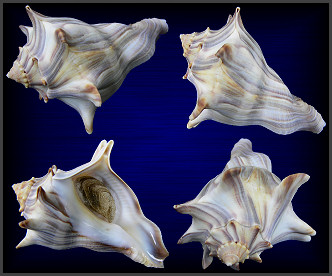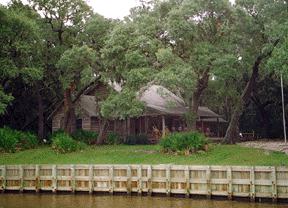| Shells, Sharks Teeth, And An Armadillo |
| By Bill Frank |
|
On a sunny and very hot Sunday May 19th, seven enthusiastic members of the Jacksonville Shell Club (Bill & Betsy Lyerly, Betty Hunter, Mary Reynolds, Rob and D.D. Jewell, and Bill Frank) participated in a shelling/nature study field trip to Cumberland Island, Georgia. The club's last organized visit to the island had taken place during March of 1995. The group assembled at the ranger station in downtown St. Marys for the 9 AM ferry departure and, following a pleasant 45 minute ride, arrived on the island at the Sea Camp Ranger Station. There they were met by club member, biologist, and 20-year island resident Carol Ruckdeschel and her friend Ginger from Savannah.
Carol had a 4-wheel all terrain vehicle and had been promising Bill Frank a tour of the southern portion of the island, so off they went to the jetty some three miles distant. While the flats near the jetty have a reputation for producing many of the smaller species including wentletraps, nothing noteworthy was found due at least in part to the height of the tide. However, during the six mile round-trip, some rather interesting items were seen in the drift line including a dead sea turtle, a large U.S. Coast Guard navigational buoy, and quite a number of onions. According to Carol, fruits and vegetables to also include squash and bananas in edible condition are commonly washed onto the beach. Also found on the beach was a live armadillo, which was only minutes away from becoming lunch for a ravenous flock of vultures. It was Carol to the rescue and after being given some water to drink and bathed to reduce its temperature, the critter revived and was transported to safer climes. With their limited eyesight, the armadillos often inadvertently wander onto the beach, where they are overcome by the heat and perish. Also on the beach to escape the flies were a number of Cumberland's wild horses, the population of which is estimated by some to be as many as 240. Because of the island's inability to support such a large herd, plans are currently being formulated to reduce this number by as much as 75 percent, according to a National Park Service Ranger.
Since some of the group did not wish to return to the beach's oppressive afternoon heat, Carol provided directions to a dredge spoil pile where fossils are not uncommon. Making the trip, which took 45 minutes each way, were Bill, Betsy, and Mary. Although not many fossil shells were seen, Betsy's persistence resulted in a handful of sharks teeth. With low tide and ferry departure rapidly approaching, Bill Frank conducted a brief last minute reconnaissance of the beach to see what live shells had been exposed by the ebbing water. Species found included the ever present B. carica form eliceans, Sinum perspectivum (Baby's Ear Moon) (1), Neverita duplicata (1000's), Oliva sayana (1), and Phrontis acuta (Sharp-knobbed Nassa) (1000's). With everyone by now hot, tired and in possession of all the shells that they wanted, it was back aboard the Cumberland Queen for the return to the mainland, happy to have had the opportunity to visit this unspoiled and pristine south Georgia barrier island in the company of friends. Special thanks to Carol for traveling the 15 miles from her home on the north end of the island to host the club's visit. |
 As low tide was not to occur for an additional four
hours, the group perused the drift line at the high water mark
and were not disappointed. By far the most common species were Dinocardium
robustum (Giant Atlantic Cockle) in numbers sufficient
to fill a small truck, and both Busycon carica form
eliceans (Kiener’s Whelk) and Dosinia
discus (Disk Dosinia) by the many thousands. Also
present, but in significantly lesser numbers, were Neventa
duplicata (Shark-eye Moon), Oliva sayana (Lettered
Olive), Busycotypus canaliculatus (Channeled
Whelk), and
Busycon perversum (Lightning
Whelk), among others.
As low tide was not to occur for an additional four
hours, the group perused the drift line at the high water mark
and were not disappointed. By far the most common species were Dinocardium
robustum (Giant Atlantic Cockle) in numbers sufficient
to fill a small truck, and both Busycon carica form
eliceans (Kiener’s Whelk) and Dosinia
discus (Disk Dosinia) by the many thousands. Also
present, but in significantly lesser numbers, were Neventa
duplicata (Shark-eye Moon), Oliva sayana (Lettered
Olive), Busycotypus canaliculatus (Channeled
Whelk), and
Busycon perversum (Lightning
Whelk), among others. After lunch in the shade of the massive oaks at the
Sea Camp beach picnic area where a trio of grey squirrels
demonstrated their fervent desire to share a ham sandwich, it was
back across the island to the shady porch of the ranger station
to rest and rehydrate.
After lunch in the shade of the massive oaks at the
Sea Camp beach picnic area where a trio of grey squirrels
demonstrated their fervent desire to share a ham sandwich, it was
back across the island to the shady porch of the ranger station
to rest and rehydrate.